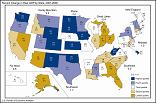Overview of the U.S. Economy: Perspective from the BEA Accounts
BEA produces some of the most closely watched economic statistics that influence decisions of government officials, business people, and individuals. These statistics provide a comprehensive, up-to-date picture of the U.S. economy. The data on this page are drawn from featured BEA economic accounts.
National Economic Accounts:
Gross Domestic Product (GDP)
Current Numbers:
- 2nd quarter 2009: -1.0 percent
- 1st quarter 2009: -6.4 percent
Next release:
August 27, 2009
Quarterly data:
Real gross domestic product -- the output of goods and services produced by labor and property
located in the United States -- decreased at an annual rate of 1.0 percent in the second quarter of 2009,
(that is, from the first quarter to the second), according to the "advance" estimate released by the Bureau
of Economic Analysis. In the first quarter, real GDP decreased 6.4 percent.

Personal Income
Current Numbers:
- June 2009: -1.3 percent (personal income)
- May 2009: 1.3 percent (personal income)
Next release:
August 28, 2009
Monthly data:
In June 2009, real disposable personal income decreased 1.8 percent.

Industry Economic Accounts:
Annual Industry Accounts: GDP by Industry
Annual Data: Downturns in manufacturing, retail trade, and finance and insurance industries were the leading contributors to the slowdown in U.S. economic growth in 2008, according to preliminary statistics on the breakout of real gross domestic product (GDP) by industry from the Bureau of Economic Analysis. The economic slowdown was widespread: nearly two-thirds of private industries contributed to the deceleration in real GDP growth.
- Highlights (PDF • 36KB)
- Detailed Press Release
- Previous Releases

International Economic Accounts:
U.S. Balance of Payments (International Transactions)
Current Account Balance:
- 1st quarter 2009: -$101.5 billion
- 4th quarter 2008: -$154.9 billion
Next release:
September 16, 2009
Quarterly data:
The U.S. current-account deficit decreased $53.4 billion to $101.5 billion (preliminary) in the first quarter of 2009.

International Investment Position
Annual data:
The U.S. net international investment position at yearend 2008 was -$3,469.2 billion (preliminary), as the value of foreign investments in the United States exceeded the value of U.S. investments abroad.

International Trade in Goods and Services
Trade Balance:
- June 2009: -$27.0 billion
- May 2009: -$26.0 billion
Next release:
September 10, 2009
Monthly data:
Total June exports of $125.8 billion and imports of $152.8 billion
resulted in a goods and services deficit of $27.0 billion.
(Joint release with the U.S. Census Bureau)

Regional Economic Accounts:
Gross Domestic Product (GDP) by State
Next release: November 2010
Annual Data: New statistics released today by the U.S. Bureau of Economic Analysis show that economic growth slowed in most states and regions of the U.S. in 2008 as economic growth overall slowed. Real GDP growth slowed in 38 states, with downturns in construction, manufacturing, and finance and insurance restraining growth in many states.
- Highlights (PDF • 119KB)
- Detailed Press Release
- Previous Releases

Gross Domestic Product (GDP) by Metropolitan Area
Next release: September 24, 2009
Annual data: Newly available statistics released today by the U.S. Bureau of Economic Analysis show that real GDP by metropolitan area grew in 308 of 363 metropolitan (statistical) areas in 2006.

State Personal Income (SPI)
Next release: September 18, 2009
Quarterly data: U.S. personal income continued to decline in the first quarter of 2009, falling 0.5 percent and encompassing 37 states.
- Highlights (PDF • 122KB)
- Detailed Press Release
- Previous Releases

Metropolitan Area Personal Income
Annual data: Personal income growth slowed in 2008 in most of the nation’s metropolitan statistical areas.
- Highlights (PDF • 158KB)
- Detailed Press Release
- Previous Releases

Local Area Personal Income
Annual data: The percent change from 2006 to 2007 in county personal income ranged from -11 percent in McPherson County, Nebraska to 88 percent in Campbell County, South Dakota.
- Highlights (PDF • 212KB)
- Detailed Press Release
- Previous Releases

County Estimates of Compensation by Industry, 2005-2007
Annual data: Total compensation of U.S. workers grew 5.2% in 2007 and most counties shared in that growth.


















